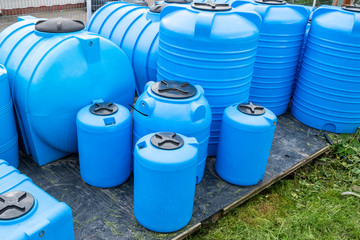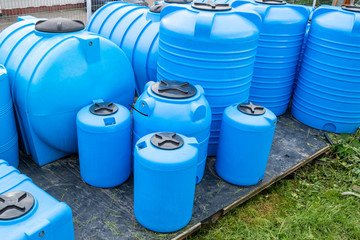This article was originally published by Mac Slavo at SHTFPlan on March 21, 2020.
Water storage is a bit tricky for most people. Few are fortunate enough to have a well on their property and a means of removing water from it without electricity. But since there are a lot of new preppers out there now, we have decided to put together a helpful guide on how to store water for a short and long-term emergency.
In a short-term emergency, even if the power goes or you’re experiencing a massive storm, bottled water can be purchased at grocery stores. But there are other ways to have it on hand in case of an emergency and you don’t want to battle anyone at the store. You could just buy a few cases of water beforehand and keep them around, but the plastic bottles will eventually begin to break down and could leech plastic into your drinking water. If you plan to store bottled water for a short-term emergency, make sure to drink it every year and replace it before the leaching process can begin.
Unlike the water itself, which has existed on Earth for 4.5 billion years, that manufactured plastic bottle only has so much time before it “goes bad.” The plastic bottles that water comes packaged in (usually polyethylene terephthalate (PET) for retail bottles and high-density polyethylene (HDPE) for water cooler jugs). The bottle will eventually fail (expire) and begin to leach plastic chemicals into the water with an effect on the overall taste. So if you happen to find a water bottle well past its printed expiration date in your home, it’s probably safe to drink, if you don’t mind the chemical bits of bottle which have broken down and are now swirling around in it, but you should also be aware of the fact that it might not be super fresh tasting anymore either. But in a life and death situation, you could drink well-expired bottled water and probably be alright. Howver, there are many other options for storing water that could help you avoid drinking the plastic. –Ready Nutrition
Food Grade Plastic Containers
These are an excellent option. Make sure you choose BPA-free containers. These will be safer and if your water is not stored correctly, it can (and will) become toxic. These containers come in a variety of sizes, but if you want long-term water storage you’ll want some pretty big ones. The benefits of a BPA-free food-grade plastic is definitely the weight and durability. These containers are difficult to break if you’re using them correctly and they are light enough to move around until you decide where you want them. Once you have water in them though, they’ll obviously be pretty heavy.
Glass Containers
I am not a fan of these, personally. (But they may work for you. Remember, prepping is about what works best for you, in your life.) They are heavy and easy to drop and break. The cost isn’t worth it to me, however, glass is going to be your best bet if you are concerned about leeching. There is no chance that a glass container will leech. But getting big enough containers to store enough water for the long term can be difficult and is often beyond the budget for some. Two 64 oz. jugs cost about $20 or, this pack of 4 glass one-gallon jugs costs $32. By comparison, the plastic jug (pictured to the left) holds 15 gallons of water and costs $79.
How Much Water Should You Store?
The general “rule of thumb” is to store one gallon of water per person per day. This may not be enough though if you want to wash clothes and dishes and bathe, but with conservation methods, you could certainly make that work. A better goal is to store two gallons per person per day and get enough for a two-week emergency when you first start. Build your storage from there. It’s always better to have it and not need it than need it and not have it, and that especially applies to your water.
Filtration
You will also want a way to filter water. If an emergency or disaster stretches out, (or you’re just beginning and you only have a couple of gallons of water stored) you are going to have to find another source of water when you diminish your storage. A lot of people like LifeStraws, but a lot of people like the Sawyer water filtration system too. This portable Berkely water filter (pictured to the right) is pricey but highly rated. Another good suggestion is to grab some water purification tablets. I keep these in my vehicle emergency kit. Tablets will eventually get used up and are a better plan for a short-term survival situation.
Survival Water Filter DIY – What to do in an Emergency!
Remember to be safe with your water! Drinking water directly from a lake or stream can make you very sick, which is why we have included several ways for you to filter water. Lakes and streams can contain viruses, bacteria, protozoans, and parasites which can cause severe illness. (Click here for more information from the CDC about contaminates in natural water sources.)
Hopefully, this will give the newer preppers out there some ideas for their water storage and filtration. If anyone has any other tips for beginners, be sure to leave them in the comments!
Why NOT To Store Rice In A Used Soda Bottle & Alternatives For Storage
The post Prepping Tips: Long & Short Term Water Storage first appeared on SHTF Plan – When It Hits The Fan, Don’t Say We Didn’t Warn You.





